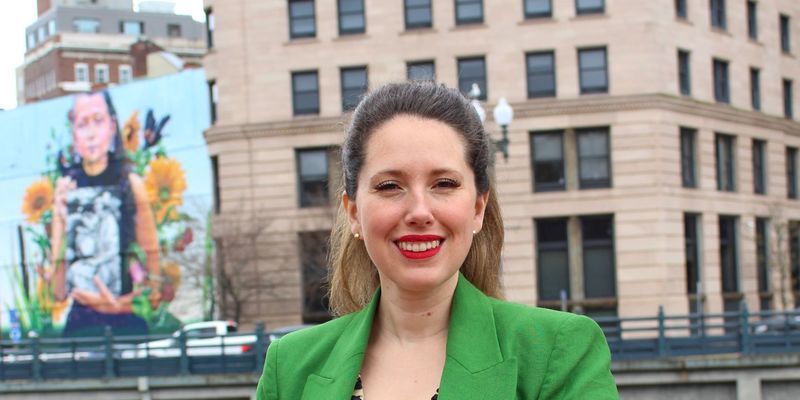Artist Karyn Olivier finds that patiently doing the work pays off
More than 25 years after switching careers, Karyn Olivier was invited to participate in this spring and summer’s Whitney Biennial, the most important exhibition of contemporary art in the country.

If you wander around Karyn Olivier’s studio, you might see bright orange construction barriers, inflated Dunnage bags used for shipping goods, a pile of tangled rope or a piece of driftwood. The professor of sculpture at the Tyler School of Art and Architecture isn’t sure if or how she’s going to use these items in her work, but she’s not exactly in a rush to figure that out, either.
Patience has been a useful tool throughout Olivier’s career. At 30 years old, she left a business career in New York City to take art classes in Philadelphia. Now at 56, Olivier was selected to participate in this year’s Whitney Biennial, considered the most important exhibition of contemporary art in the country. She’s had multiple studio visits from curators at the Manhattan-based Whitney Museum of American Art in the past decade, but being included in the 2024 biennial is a significant milestone in her career.
“The idea that this is happening 25 years after deciding to pursue art is pretty incredible, and really an honor,” Olivier said of her inclusion in the biennial, which remains on view until Sept. 29. “I have had a very fortunate career over the last two decades, but it’s hard to be included in the Whitney Biennial and wonder if you made the right choice,” she laughed.
Olivier has become well known for her public art installations and memorial works that examine history, or what she describes as “the fragmented manner in which we learn about the past.” In 2017, she built a mirrored surface around the Battle of Germantown monument, which honors the actions of George Washington during the Revolutionary War. Olivier’s piece was called “The Battle Is Joined,” and it invited visitors to literally see their reflection in history and become a part of the monument itself.
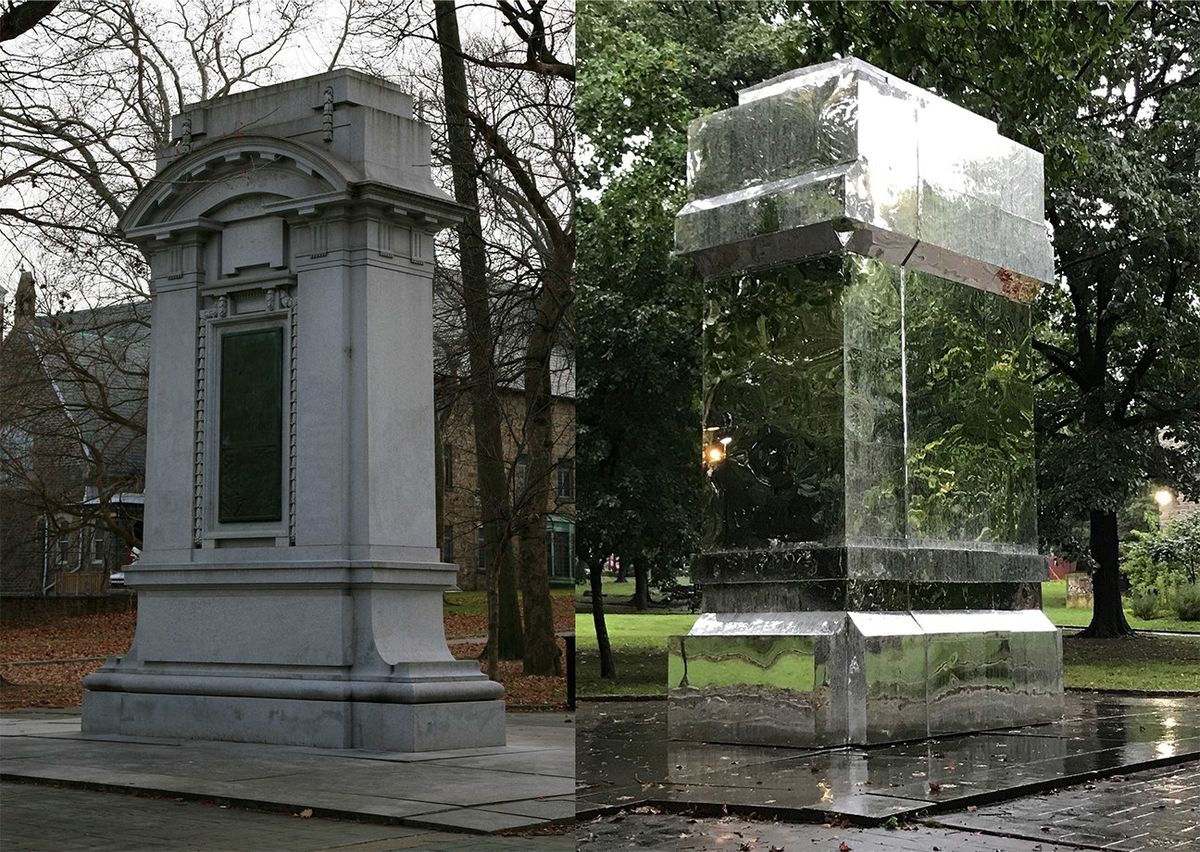
On the left is the Battle of Germantown monument. On the right is Karyn Olivier's "The Battle Is Joined." (Photography courtesy of the artist)
Presenting discrete sculptures at the Whitney Biennial
Olivier thought the Whitney might invite her to present bigger work more akin to her public installations, so she was pleasantly excited, and a bit nervous, when they instead requested two smaller and more discrete sculptures.
In one of the works, titled “How Many Ways Can You Disappear,” Olivier suspends a cluster of worn buoys from white rope, so bright and pure that one visitor thought it was made from marble. The rope, which is in fact cast from salt, dangles buoys from the ceiling above a tangled and mismatched pile of fishing line and crushed lobster traps.
To Olivier, the sea salt still embedded in both the braided rope and the fishing lines references salt’s many histories.
“I was thinking about the trading of salt for enslaved people in Ancient Greece,” she said. “You could also think about the Middle Passage and about displacement, both of people but also of these materials.”
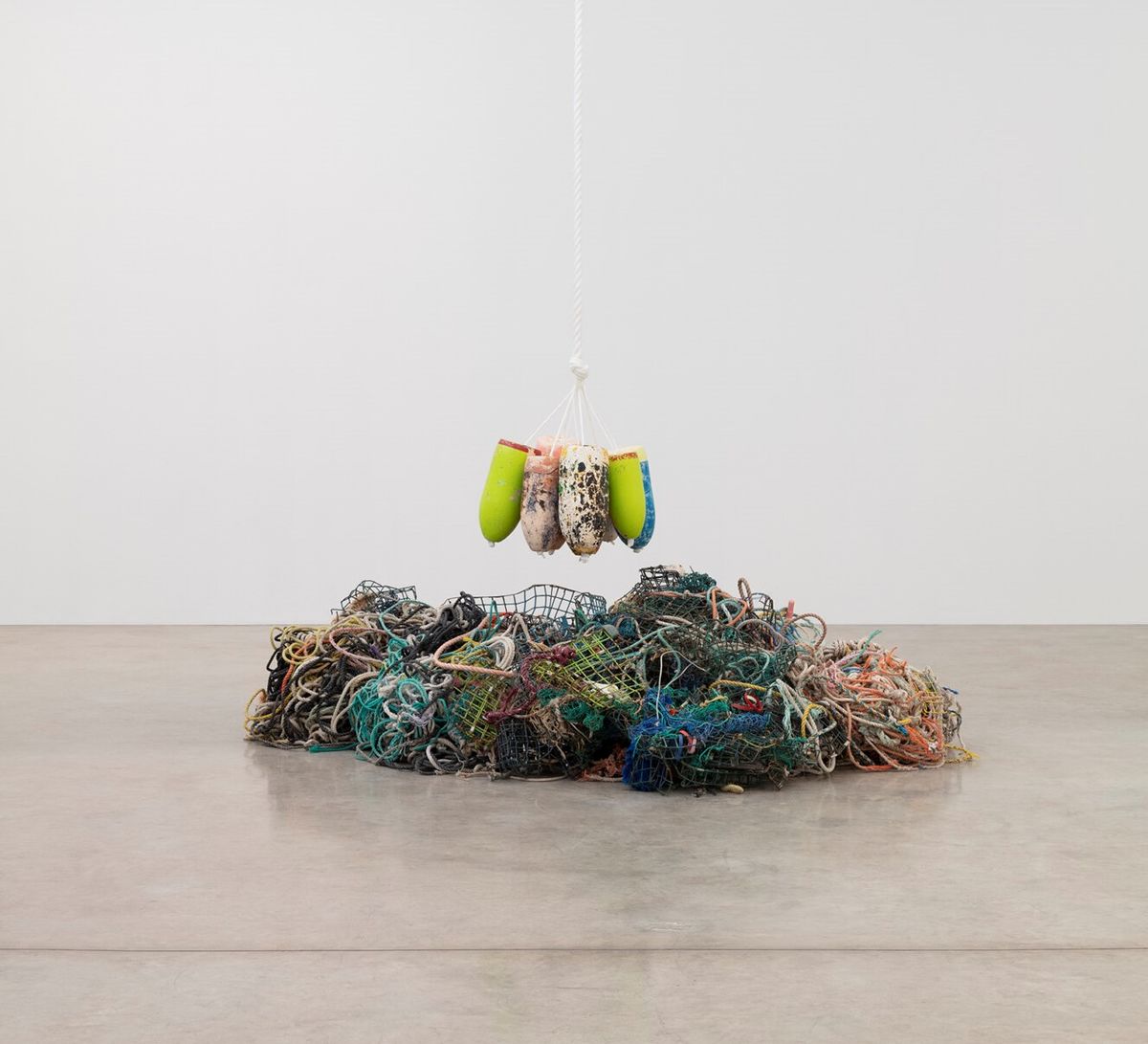
"How Many Ways Can You Disappear" by Karyn Olivier. (Photography courtesy of the artist)
The other work, “Stop Gap,” was created by Olivier amidst the difficulties of the 2020 COVID-19 lockdown. It features a weathered and forked piece of driftwood attached to a steel base. The area between the two limbs of driftwood is filled with a colorful heap of clothing scraps.
“I started looking at that space in the driftwood as an unfulfilled gap,” Olivier said. “I decided to load it with fragments of used clothing, thinking about the term ‘stop gap’ and the temporary measures so many of us were taking to hold things in place at that time.”
Both works contain materials—the buoys and fishing line in “How Many Ways Can You Disappear” and the driftwood in “Stop Gap”—that were collected from the beaches of Matinicus Isle, Maine, where Olivier’s wife’s family owns a home.
Olivier says the island lacks cute stores or restaurants but is instead a remote and tranquil summer spot for returning families, as well as a rugged year-round home to a fishing community. She’s spent many summers walking its beaches collecting washed up buoys, lobster traps, driftwood and tangled masses of fishing lines, some of which find their way into her art.
Both works are also the result of Olivier’s determined patience. The driftwood in Stop Gap sat in her studio for eleven years before she had a clear vision of how to use it. The tangled fishing line in “How Many Ways Can You Disappear” spent close to a decade in her studio as she struggled with multiple iterations.
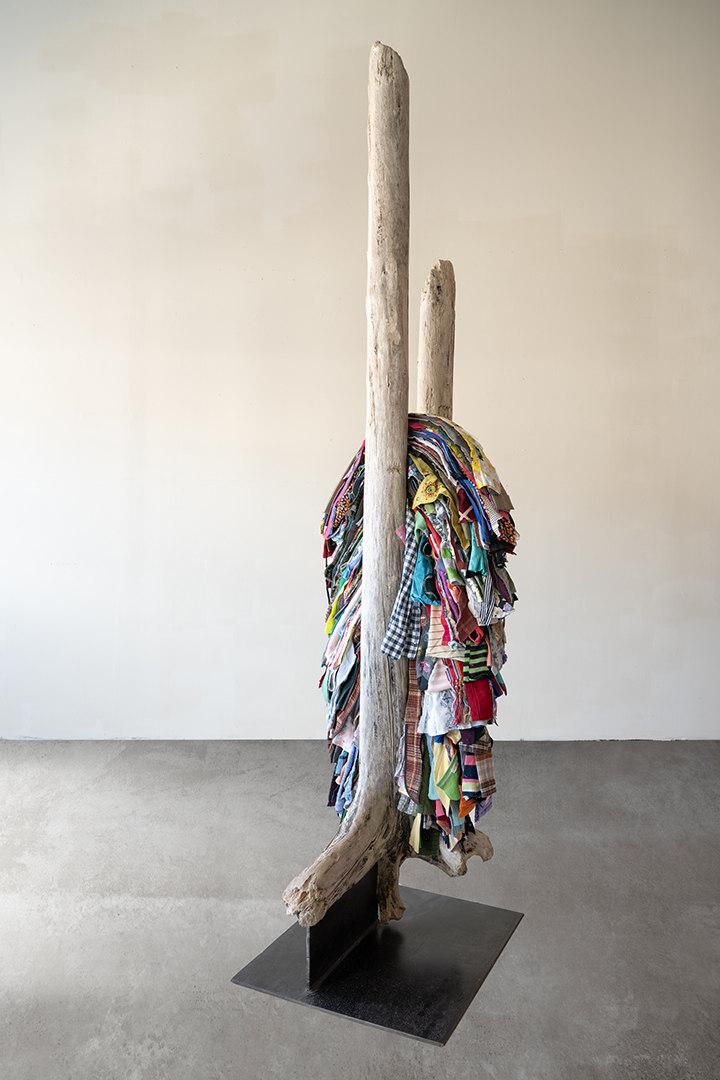
"Stop Gap" by Karyn Olivier. (Photography courtesy of the artist)
“These things wash up and they have no function. A buoy is supposed to hold things up, and instead it’s just lying there on the shore. But in a way, every object can have a new function. I’m from the Caribbean where everything can be used for another purpose—nothing gets squandered,” said Olivier, who was born and spent part of her childhood in Trinidad and Tobago. “I kept thinking, what am I going to do with this piece?”
Patience, trust and history
It’s not uncommon for Olivier to spend considerable time sitting with and thinking about materials and how she wants to use them. One day in 2022 during her residency at RAIR, a recycled art program in Philadelphia, a truck showed up and dumped 30 construction barriers. She didn’t know what to do with them, but she wanted to find a way to incorporate them into a piece. They have since been part of two installations, and she’ll be using the barriers again in a work she’s presenting at the Prospect New Orleans Triennial later this year.
“I can’t say why I was drawn to the construction barriers,” Olivier laughed. “I just trust the materials, and I’ve learned not to throw them away.”
Olivier spends a lot of time thinking about history, especially when working on her public memorial pieces. In April, she unveiled “Right Here,” a memorial at Germantown’s Stenton House that honors Dinah, a former slave worker at the mansion. Dinah earned her freedom after she saved the mansion from being burnt to the ground by British soldiers, but she remained a servant at Stenton House.
The memorial features a circular stone seating area and two large stone tablets, each inscribed with questions visitors might ask Dinah, as well as questions Dinah might ask the memorial’s visitors.
One of the inscriptions reads, “Did you ever wish you had let it burn?”
“I felt like that question had to be included. Because yes, she worked to get herself free, but she was still a servant. Yes, maybe they treated her with care, but she was still indebted,” Olivier said. “These questions that we’re asking her earnestly, they keep her alive.”
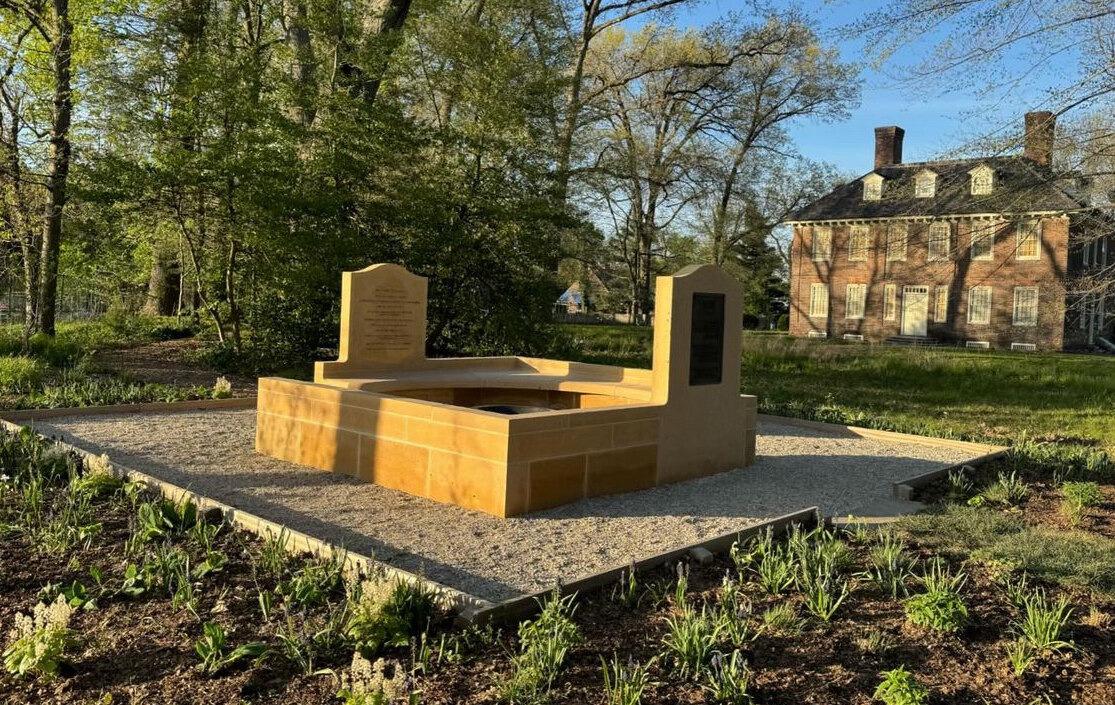
"Right Here" by Karyn Olivier. (Photography courtesy of the artist)
Staying busy in her 18th year as Tyler faculty
It will be a busy fall semester for Olivier. She is currently working on the Bethel Burying Ground Historic Memorial, which will honor more than 5,000 19th-century Black Philadelphians buried beneath Weccacoe Playground in Queen’s Village. She expects it to be complete in 2025.
Olivier is featured in Temple Contemporary’s fall exhibition Black Like That: Our Lives As Living Praxis. The exhibition explores Black culture as an active expression of archival practice. Olivier is working on a memorial at the Germantown Potter’s Field as part of her inclusion in the exhibition.
She’s also showing work this autumn in a handful of other exhibitions: the Manhattan-based El Museo del Barrio’s triennial, Rice University’s Off the Wall commission series and the Prospect New Orleans Triennial. And earlier in September, Olivier won the 2024 Ellsworth Kelly Award to support a 2026 solo exhibition at the Museum of Contemporary Art in Detroit.
Of course, she’s also looking forward to teaching students in her 18th year as Tyler faculty.
“I think it’s good for me to be aware of what I have to offer, in terms of experience in years and a seasoned perspective,” Olivier said. “But also to recognize that my students have this thing that I can’t have, because I’m not growing up now, that I want to take in and understand.
“It is exciting and inspiring to see that art—which I’ve devoted my life to making and teaching—still has as much power and relevance for these young people just beginning their careers.”
